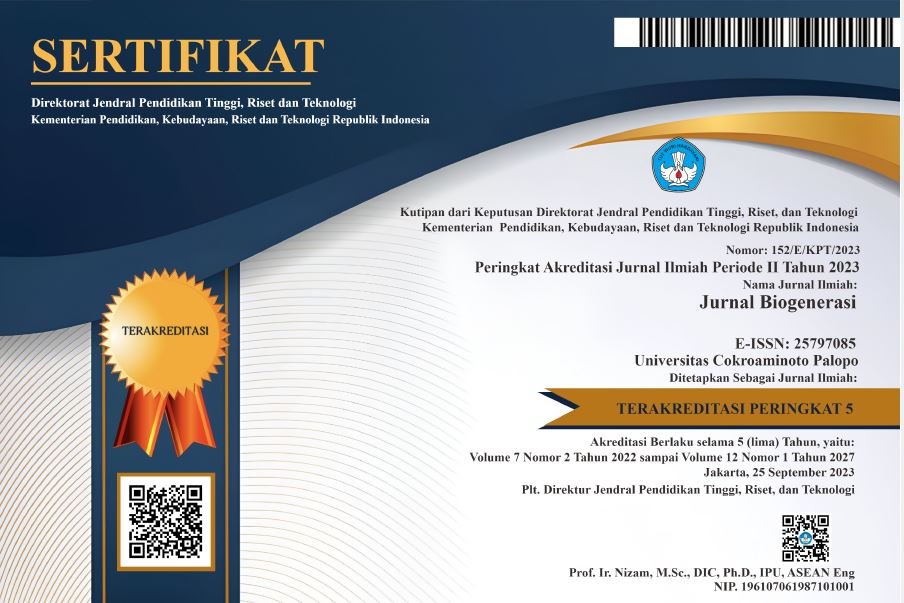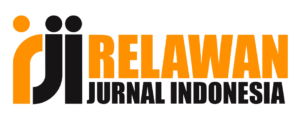ANALISIS PERTUMBUHAN PLANLET RUMPUT LAUT (Gracilaria Verrucosa) DI BALAI PERIKANAN BUDIDAYA AIR PAYAU (BPBAP) TAKALAR, SULAWESI SELATAN
DOI:
https://doi.org/10.30605/biogenerasi.v10i2.5479Keywords:
Gracilaria Verrucosa, Growth, BPBAP TakalarAbstract
This research aims to determine the growth of Gracilaria verrucosa seaweed plantlets and to determine the environmental parameters that support the growth of Gracilaria verrucosa seaweed in the BPBAP Takalar seaweed tissue culture laboratory. This research took place in seaweed tissue culture, Takalar Brackish Water Aquaculture Fisheries Center (BPBAP), Mappakalompo Village, South Galesong District, Takalar Regency, South Sulawesi Province. This research was carried out for four months, namely from August to December 2024. The research method used analysis of variance to see the comparison of growth rates. The parameters observed during the research were observations of absolute growth, specific growth rate and ADG (Avarage Daily Growth). Based on the results obtained in this research, it can be concluded that container 1 has a higher average growth rate compared to container 2 and container 3. The respective average growth rates for container 1, container 2, and container 3 are 0.511%, 0.274%, 0.407%. Environmental parameters that support the growth of Gracilaria verrucosa seaweed plantlets include temperature, light intensity, salinity and fertilizer.
Downloads
References
Ariadi, H. 2024. Silvofishery: Opsi Pengelolaan Sumberdaya Pesisir. Pustaka Saga Jawadwipa. Surabaya
Anggadiredja, J.T., A. Zatnika, H. Purwoto, dan S. Istini. 2010. Rumput Laut:Pembudidayaan, Pengolahan, dan Pemasaran Komoditas Perikanan Potensial. Jakarta: Penebar Swadaya.
Cokrowati, N., Arjuni, A., & Rusman, R. 2018. Pertumbuhan Rumput Laut Kappaphycus Alvarezii Hasil Kultur Jaringan. Jurnal Biologi Tropis, 18(2), 216–223.
FAO. (2021). The State of World Fisheries and Aquaculture 2021 (SOFIA).
Hardan, H., Warsidah, W., & Nurdiansyah, I. S. (2020). Laju pertumbuhan rumput laut Kappaphycus alvarezii dengan metode penanaman yang berbeda di perairan laut desa Sepempang Kabupaten Natuna. Jurnal Laut Khatulistiwa, 3(1), 14-22.
Hesti Mulyaningrum, S. R., Parenrengi, A., & Suryati, E. (2015). Pertumbuhan dan Perkembangan Eksplan Rumput Laut Gracilaria verrucosa dan Gracilaria gigas pada Aklimatisasi di Tambak. ILMU KELAUTAN: Indonesian Journal of Marine Sciences, 20(3).
Irawati, B. A., & Affandi, R. I. (2024). Kultur Jaringan Rumput Laut Kappaphycus Alvarezii Dengan Metode Embriogenesis Somatik. Ganec Swara, 18(1), 358-368.
Mapparimeng, M., Liswahyuni, A., Permatasari, A., Fattah, N., & Aminullah, A. (2019). Laju Pertumbuhan Rumput Laut (Gracilaria Sp) Dengan Pola Rak Bertingkat Di Tambak Kelurahan Samataring Kecamatan Sinjai Timur Kabupaten Sinjai. Agrominansia, 4(1), 71-82.
Mubarok, R. M. M. R. Al, & Farikhah. (2024). Pertumbuhan Udang Vannamei (Litopenaeus Vannamei) Di Tambak Intensif Dengan Manajemen Plankton Sebagai Penyeimbang Ekosistem. Jurnal Perikanan Pantura (JPP), 7(1), 435–449.
Munaeni, W., Lesmana, D., Irawan, H., Hamka, M. S., & Nafsiyah, I. (2023). Potensi Budidaya dan Olahan Rumput Laut di Indonesia. Tohar Media.
Nisak, F., Rahimi, A. El, Hasri, I., Studi, P., Perairan, B., Kelautan, F., & Perikanan, D. (2017). Variasi Periode Penyinaran (Fotoperiod) Terhadap Pertumbuhan dan Kelangsungan Hidup Larva Ikan Peres (Osteochilus kappeni) Variation Of Photoperiod On The Growth And Survival Rate Of Peres Fish Larvae (Osteochilus kappeni). Jurnal Ilmiah Mahasiswa Kelautan Dan Perikanan Unsyiah, 2(2), 319–328.
Supiandi, M., Cokrowati, N., & Rahman, I. (2020). Pengaruh Perbedaan Jarak Tanam Terhadap Pertumbuhan Rumput Laut (Eucheuma Cottonii) Hasil Kultur Jaringan Dengan Metode Patok Dasar Di Perairan Gerupuk. Jurnal Perikanan Unram, 10 (2), 158–166. Https://Doi.Org/10.29303/Jp.V10i2.206
Setiawan, K. (2019). Metodologi Penelitian (Anova Satu Arah). Lampung: Universitas Lampung.
Sapitri, A. R., & Cokrowati, N. (2016). Pertumbuhan rumput laut Kappaphycus alvarezii hasil kultur jaringan pada jarak tanam yang berbeda. Depik, 5(1).
Downloads
Published
How to Cite
Issue
Section
License
In submitting the manuscript to the journal, the authors certify that:
- They are authorized by their co-authors to enter into these arrangements.
- The work described has not been formally published before, except in the form of an abstract or as part of a published lecture, review, thesis, or overlay journal.
- That it is not under consideration for publication elsewhere,
- That its publication has been approved by all the author(s) and by the responsible authorities – tacitly or explicitly – of the institutes where the work has been carried out.
- They secure the right to reproduce any material that has already been published or copyrighted elsewhere.
- They agree to the following license and copyright agreement.
License and Copyright Agreement
Authors who publish with this journal agree to the following terms:
- Authors retain copyright and grant the journal right of first publication with the work simultaneously licensed under Creative Commons Attribution License (CC BY 4.0) that allows others to share the work with an acknowledgment of the work's authorship and initial publication in this journal.
- Authors are able to enter into separate, additional contractual arrangements for the non-exclusive distribution of the journal's published version of the work (e.g., post it to an institutional repository or publish it in a book), with an acknowledgment of its initial publication in this journal.
- Authors are permitted and encouraged to post their work online (e.g., in institutional repositories or on their website) prior to and during the submission process, as it can lead to productive exchanges, as well as earlier and greater citation of published work.


.png)

